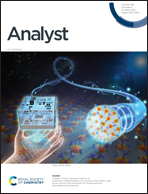Electrochemiluminescence immunoassay strategies based on a hexagonal Ru-MOF and MoS2@GO nanosheets: detection of 5-fluorouracil in serum samples†
Abstract
Herein, a competitive-type electrochemiluminescence immunosensor for ultrasensitive detection of 5-fluorouracil (5-FU) was fabricated. Ruthenium(II)-metal–organic framework (Ru-MOF) nanosheets were selected to act a promising ECL luminophore using tris(4,4′-dicarboxylic acid-2,2′-bipyridyl) ruthenium(II) dichloride (Ru(dcbpy)32+) as the organic ligand. The two-dimensional (2D) Ru-MOF nanosheets achieved an increased loading of Ru(dcbpy)32+ and effectively prevented leakage of the ECL emitter during application, which exhibited satisfactory ECL performance. Thin two-dimensional MoS2@GO was used to modify the electrode as the sensing platform for improving the electron transfer rate and loading more 5-FU coating antigens due to its large specific surface area and piezoelectric catalytic efficiency. Under the optimized conditions, the proposed immunosensor presented high sensitivity, a wide detection range (0.0001 ng–100 ng mL−1), a low limit of detection (0.031 pg mL−1, S/N = 3), good specificity and stability. Furthermore, the immunosensor was successfully applied for the detection of 5-FU in human serum samples with satisfactory results, proving this strategy has potential applications in bioanalysis and clinical diagnosis.

- This article is part of the themed collection: Analyst HOT Articles 2023


 Please wait while we load your content...
Please wait while we load your content...